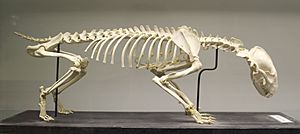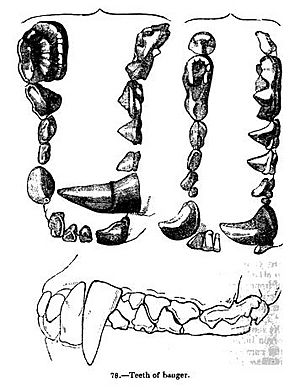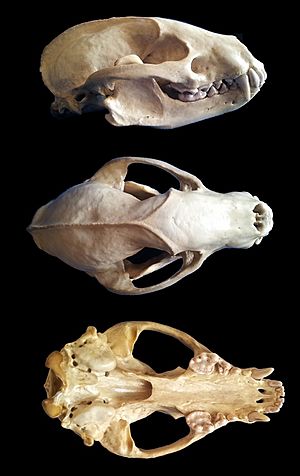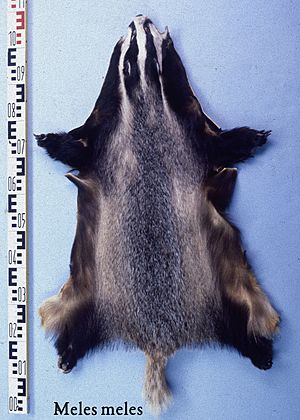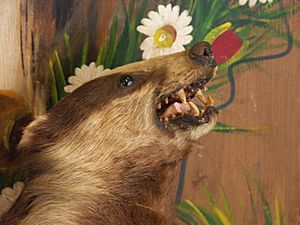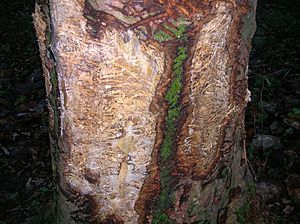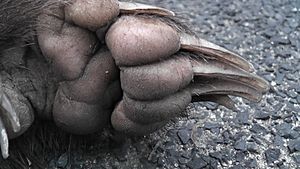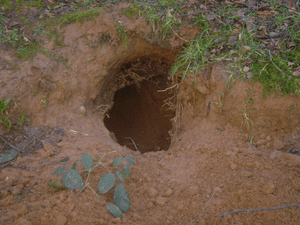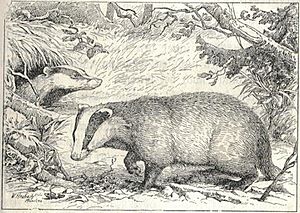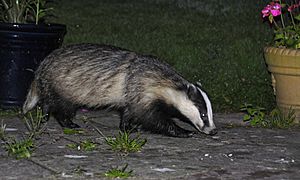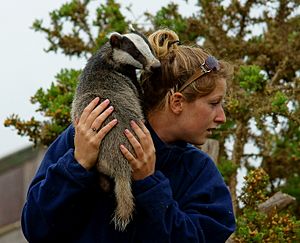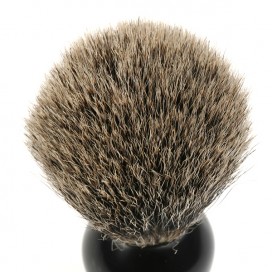European badger facts for kids
Quick facts for kids European badgerTemporal range: Mid-Pleistocene–Recent
|
|
|---|---|
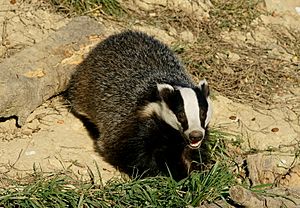 |
|
| Conservation status | |
| Scientific classification | |
| Kingdom: | |
| Phylum: | |
| Class: | |
| Order: | |
| Family: | |
| Genus: |
Meles
|
| Species: |
M. meles
|
| Binomial name | |
| Meles meles (Linnaeus, 1758)
|
|
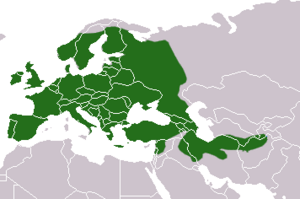 |
|
| European badger range | |
The European badger (Meles meles) is a type of badger. It lives in most parts of Europe. This animal is not in danger of extinction. The IUCN says it is of "Least Concern". This is because there are many badgers and they live in a wide area.
European badgers are social animals. They dig and live in burrows called setts. They eat many different plants and animals. Badgers are very clean. They keep their homes tidy and use special spots called latrines to go to the bathroom. They are even known to bury their dead family members. Badgers are usually peaceful. But they can be fierce if they feel threatened. They sometimes share their burrows with other animals. These can include rabbits, red foxes, and raccoon dogs. Badgers do not usually harm farm animals. However, they can sometimes spread a disease called bovine tuberculosis to livestock.
Contents
What does a European badger look like?
European badgers are strong animals. They have small heads and thick, short necks. Their bodies are wide and shaped like a wedge. They also have short tails. Their feet are short and have five toes. Badgers walk with their whole foot on the ground. Their legs are strong and heavy. Their claws are tough and long, which helps them dig. These claws cannot be pulled back. Older badgers may have very worn-down back claws from digging.
Their snouts are muscular and flexible. They use them for digging and exploring. Badgers have small eyes and short ears with white tips. They have Whiskers on their snout and above their eyes. Male badgers, called boars, usually have wider heads. They also have thicker necks and narrower tails. Female badgers, called sows, are slimmer. Their heads are narrower and less rounded. Their tails are also fluffier.
Badgers have long guts because they eat many different foods. Their small intestine is about 5.36 metres (17.6 ft) long. Both males and females have three pairs of nipples. These are more developed in females. Badgers cannot bend their backs like martens or wolverines. They also cannot stand fully upright like honey badgers. But they can run very fast.
Adult badgers are about 25–30 cm (9.8–11.8 in) tall at the shoulder. Their bodies are 60–90 cm (24–35 in) long. Their tails are 12–24 cm (4.7–9.4 in) long. Males are slightly bigger than females. But they can weigh much more. Their weight changes with the seasons. They gain weight from spring to autumn. They are heaviest just before winter. In summer, they weigh about 7–13 kg (15–29 lb). In autumn, they can weigh 15–17 kg (33–37 lb). The heaviest badger ever found weighed 27.2 kg (60 lb).
Badgers have a very good sense of smell. But their eyesight is not great. They see in black and white. They only notice things that are moving. Their hearing is about the same as a human's.
A badger's skull is large, heavy, and long. The part that holds the brain is oval. The front part of the skull is long and narrow. Adult badgers have a strong ridge on top of their skull. This ridge can be up to 15 mm tall in old males. It helps anchor their jaw muscles. It also protects their skull from hard hits.
Badgers have teeth that are good for eating many kinds of food. Their front teeth are small and sharp. Their canine teeth are noticeable. Their special cutting teeth are not too sharp. Their back teeth are flat for grinding food. Their jaws are strong enough to crush most bones. A badger once bit a man's wrist so hard that his hand had to be removed.
Badgers have Scent glands under their tail and near their bottom. These glands make different smells. One gland makes a musky, creamy liquid. The other makes a stronger, yellowish-brown liquid.
Badger fur and colors
In winter, the fur on a badger's back and sides is long and rough. It has stiff guard hairs and a soft undercoat. The fur on their belly is short and thin. The throat, lower neck, chest, and legs are black. The belly is lighter and brownish. The back and sides are light silvery-grey. They have straw-colored highlights on their sides. The tail has long, coarse hairs and is the same color as the back.
Badgers have two black stripes on their head. These stripes start at the upper lip and go up to the ears. They sometimes go down the neck and blend with the body color. A wide white stripe goes from the nose tip, over the forehead, and to the top of the head. White markings are also on the lower part of the head and neck.
Summer fur is rougher, shorter, and thinner. It is also darker. The black parts become brownish, sometimes with yellow hints. Some badgers can have partial melanism, which means they are darker than usual. Albino badgers are also common. They can be pure white or yellowish with pink eyes. Badgers with Erythrism are more common. They have a sandy-red color where the fur is usually black. Yellow badgers are also known.
Badger behavior and life cycle
How badgers live together
European badgers are the most social type of badger. They live in groups of about six adults. Some groups can have up to 23 badgers. The size of the group can depend on where they live. In good areas, a badger group's territory can be as small as 30 ha. In other areas, it can be as large as 150 ha. You can tell where badger territories are by their shared latrines and well-used paths.
Male badgers are usually the ones that fight over territory. It is thought that badgers have a social ranking system. Large, strong male badgers seem to be in charge of smaller males. During mating season in early spring, large males sometimes go into other groups' territories. This can lead to fights. However, badgers usually get along well with others in their group and even with badgers from other groups. Males mark their territory more than females. They do this more often during mating season.
Badgers groom each other carefully with their claws and teeth. This grooming might help them bond. Badgers are active at dawn and dusk, and at night. Fights between badgers are mostly about defending their territory or mating. When they fight, they bite each other's necks and backs. They also run and chase each other. These fights can cause serious injuries, and sometimes even death. When dogs attack badgers, they may raise their tails and fluff up their fur.
Badgers make many different sounds. When they feel threatened, they growl deeply. When fighting, they make low "kekkering" noises. They bark when surprised. They whicker when playing or in trouble. And they make a loud scream when they are scared or alarmed.
Badger reproduction and development
A female badger usually has one to five cubs in a litter. Many cubs are fathered by males from their own group. But up to 54% can be fathered by males from other groups. Dominant female badgers may kill the cubs of other females in the group.
Cubs are born pink with grayish, silvery fur. Their eyelids are closed. Newborn badgers are about 12 cm (5 in) long. They weigh between 75 to 132 grams (2.6 to 4.7 oz). Cubs from larger litters are usually smaller. Their claws get color after three to five days. Dark hairs start to appear. Their eyes open when they are four to five weeks old. Their milk teeth also start to come in around this time.
Cubs come out of their setts when they are eight weeks old. They start to be weaned at twelve weeks. But they may still drink milk until they are four to five months old. Other female badgers in the group help the mother. They guard, feed, and groom the cubs. Cubs get their full adult fur when they are six to nine weeks old. In areas with many badgers, cubs usually stay with their birth group. But they might visit other groups for a short time. Badgers can live for up to about fifteen years in the wild.
Badger homes: Setts
European badgers are excellent diggers. Their homes, called setts, are very complex. They are often used by many generations of badgers. A sett can have a few exits or as many as fifty. Some setts are huge and can house several badger families. Each family will have its own tunnels and sleeping rooms. Some exits are only used when there is danger or for play.
A typical tunnel is about 22–63 cm (8.7–24.8 in) wide and 14–32 cm (5.5–12.6 in) high. A family unit usually has three sleeping rooms. Some of these rooms are open at both ends. The main sleeping room is about 5–10 m (5.5–10.9 yd) from the entrance. It is usually more than 1 m (1.1 yd) underground, sometimes as deep as 2.3 m (2.5 yd). The tunnels are usually 35–81 m (38–89 yd) long. The sleeping room is about 74 cm × 76 cm (29 in × 30 in) and 38 cm (15 in) high.
Badgers dig and gather bedding all year, especially in autumn and spring. Younger females and dominant males usually take care of the sett. The sleeping rooms are often lined with bedding. This bedding is brought in on dry nights. It can be grass, bracken, straw, leaves, and moss. A badger can carry up to 30 bundles of bedding in one night.
European badgers are very clean animals. They regularly clean out old bedding. In winter, they might take their bedding outside on sunny mornings. They bring it back later in the day. They clean their setts especially when cubs are born. They may clean several times in summer to prevent parasites. If a badger dies inside the sett, other badgers will seal off that room and dig a new one. Some badgers will even drag their dead out of the sett and bury them outside.
A sett is almost always near a tree. Badgers use these trees for stretching or sharpening their claws. Badgers use special spots called latrines to go to the bathroom. These are near the sett, at territory borders, or near places with lots of food. If there are no good places to dig, badgers might even live in haystacks in winter. They sometimes share their setts with red foxes or European rabbits. Badgers might protect rabbits from other predators. Rabbits usually stay safe by living in smaller, hard-to-reach parts of the sett.
Winter rest
Badgers get ready for winter sleep in late summer. They build up fat reserves, which are highest in October. During this time, they clean their sett and fill their sleeping room with bedding. When they go to sleep, badgers block their sett entrances with dry leaves and earth. They usually stop leaving their setts once snow falls. In cold places like Russia, badgers sleep from late October to mid-November. They come out in March and early April. In places with milder winters, like England, badgers might not sleep much at all. They may spend long periods underground but come out during warm spells.
What do badgers eat?
European badgers are not very carnivorous, meaning they don't eat only meat. They are very flexible and eat many different things. They are omnivores. Their diet includes a wide range of animals and plants. Earthworms are their most important food. After that, they eat large insects, carrion (dead animals), grains, fruit, and small mammals. These mammals include rabbits, mice, shrews, moles, and hedgehogs.
Insect prey includes chafers, dung and ground beetles, caterpillars, and leatherjackets. They also eat the nests of wasps and bumblebees. Badgers can destroy wasp nests and eat the insects, combs, and nest material. Their thick skin and fur protect them from stings. Grains they eat include wheat, oats, maize, and sometimes barley. Fruits include fallen apples, pears, plums, blackberries, bilberries, raspberries, strawberries, acorns, beechmast, and pignuts.
Sometimes, badgers eat medium to large birds, amphibians, small reptiles (like tortoises), snails, slugs, fungi, and green plants like clover and grass. They eat these especially in winter or during dry periods. Badgers usually catch many of one type of food during each hunt. They generally eat no more than 0.5 kg (1.1 lb) of food per day. Young badgers eat more than adults. An adult badger weighing 15 kg (33 lb) eats food equal to 3.4% of its body weight. Badgers usually eat their prey where they catch it. They rarely take it back to their setts. Sometimes, they kill more chickens than they can eat in chicken coops.
Badgers hunt rabbits all year, especially when young rabbits are available. They find young rabbits in their nests by smell. Then they dig straight down to them. In mountains or hilly areas where plant food is scarce, rabbits are a main food source for badgers. Adult rabbits are usually avoided, unless they are hurt or caught in traps. Badgers eat rabbits by turning them inside out and eating the meat, leaving the skin. They eat hedgehogs in a similar way. In areas with many badgers, hedgehogs are rare.
Some badgers might kill lambs, but this is very rare. People might wrongly blame badgers for killing lambs. This is because discarded wool and bones are found near their setts. But foxes, which sometimes live near badgers, are often the ones who kill lambs. Badgers do not carry food back to their setts. They usually kill lambs by biting them behind the shoulder. They also rarely eat Poultry and game birds. Some badgers build their setts very close to poultry or game farms without ever causing harm. When badgers do kill birds, it usually happens in February–March. This is when food is scarce due to bad weather and more badgers are around. Badgers can easily break into bee hives with their jaws. They are mostly not bothered by bee stings, even when many bees attack them.
Badgers and other animals
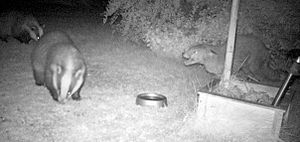
European badgers have few natural enemies. Wolves, lynxes, and dogs can be a threat. But deaths caused by them are rare. Badgers may live with red foxes in separate parts of large burrows. The two species might tolerate each other. Foxes might leave food scraps for badgers. Badgers keep the shared burrow clean. However, badgers have been known to drive foxes out of their dens. They may even destroy fox cubs without eating them.
Raccoon dogs may use badger setts a lot for shelter. There are many cases of badgers and raccoon dogs spending winter in the same hole. This might be because badgers start sleeping two weeks before raccoon dogs. They also wake up two weeks later. Sometimes, badger and raccoon dog cubs can even live in the same burrow. Badgers may chase away or kill raccoon dogs if they stay too long.
Where do European badgers live?
The European badger lives in most of Europe and parts of western Asia. In Europe, you can find them in many countries. These include Albania, Austria, Belgium, France, Germany, Great Britain, Greece, Ireland, Italy, Norway, Poland, Spain, Sweden, and Switzerland. In Asia, they live in Afghanistan, China, Iran, Iraq, and Israel.
The Volga River marks the boundary between European and Asian badgers. European badgers live on the western side of the river. They are common in European Russia. About 30,000 badgers were recorded there in 1990. Their numbers are growing across their range. This is partly because rabies has decreased in Central Europe. In the UK, badger numbers went up by 77% in the 1980s and 1990s. In 2012, there were an estimated 300,000 badgers in Great Britain.
European badgers live in different places. They like deciduous and mixed woodlands, clearings, and pastures. They have learned to live in suburban areas and city parks. But not as much as red foxes. In mountains, they can live up to 2,000 metres (6,600 ft) high.
Scientists in Ireland have used Global Positioning Systems (GPS) to track badgers. This helps them study badger behavior and territories.
Badgers in stories and culture
Badgers in folklore and literature
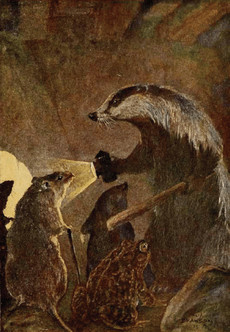
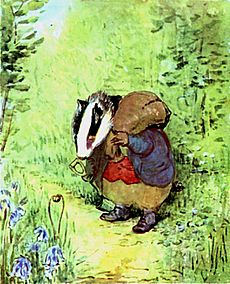
Badgers are important in European folklore. They also appear in many modern books. In Irish mythology, badgers are shown as shape-shifters. They are related to Tadg, a king and foster father of a hero. In one story, Tadg gets angry at his adopted son for killing badgers for dinner. In German folklore, the badger is seen as careful and peaceful. He loves his home, family, and comfort the most. But he can become aggressive if surprised. He is a cousin of Reynard the Fox. The badger tries to make the fox be good, but it does not work.
In Kenneth Grahame's The Wind in the Willows, Mr. Badger is a grumpy, lonely character. He "simply hates society." But he is a good friend to Mole and Ratty. He was a friend of Toad's father. So, he is often firm with Toad. But he is also patient and means well. He is seen as a wise, good leader and gentleman. He is also brave and a skilled fighter. He helps clear Toad Hall of invaders.
The "Frances" series of children's books by Russell Hoban and Lillian Hoban features a badger family that acts like humans.
In T. H. White's The Once and Future King, young King Arthur turns into a badger. This happens as part of his lessons from Merlin. He meets an older badger who tells him, "I can only teach you two things - to dig, and love your home."
A bad badger named Tommy Brock is in Beatrix Potter's 1912 book The Tale of Mr. Tod. He kidnaps the children of Benjamin Bunny and his wife Flopsy. He hides them in an oven at Mr. Tod the fox's house. He fights Mr. Tod at the end of the book. Some people criticized the book for showing the badger as dirty and taking fox dens. But these small changes helped create unique characters.
A wise old badger named Trufflehunter appears in C. S. Lewis' Prince Caspian. He helps Caspian X fight against King Miraz.
A badger is a main character in Colin Dann's The Animals of Farthing Wood series. He is second in command to Fox. The badger is also the symbol for Hufflepuff house in the Harry Potter books. The Redwall series has Badger Lords. They rule a fortress and are known as fierce warriors. The children's TV show Bodger & Badger was popular in the 1990s. It was about a badger who loved mashed potatoes and his human friend.
Badger hunting
European badgers are not very important for hunting economies. But they are hunted in some local areas. People hunt badgers by catching them in traps. They also ambush them at their setts with guns. Sometimes, they smoke them out of their homes. They also use special dogs like Fox Terriers and Dachshunds to dig them out. Badgers are very tough animals. Their skin is thick, loose, and covered in long hair, which protects them. Their strong skulls help them survive most hard hits and even shotgun pellets.
Can badgers be pets?
There are stories of European badgers being tamed. Tame badgers can be loving pets. They can be trained to come when their names are called. They are easy to feed because they are not picky eaters. They will naturally dig up rats, moles, and young rabbits without training. They especially like pork. One tame badger was known to be friends with a fox. But generally, badgers do not get along with cats and dogs. They will chase them away.
What are badgers used for?
The hair of the European badger has been used for hundreds of years. It is used to make sporrans and high-quality shaving brushes. Sporrans are traditional bags worn with male Scottish highland dress. They are made from pelt, and a badger's face might be used as a flap. Badger hair is great for shaving brushes. It holds hot water well, which is needed for wet shaving. Some brushes use hair from wild badgers. But most hair comes from China, where badgers are farmed for this purpose. In the past, badger fur was also used for parts of pistol furniture.
Images for kids
See also
 In Spanish: Tejón europeo para niños
In Spanish: Tejón europeo para niños



